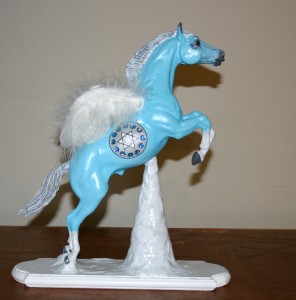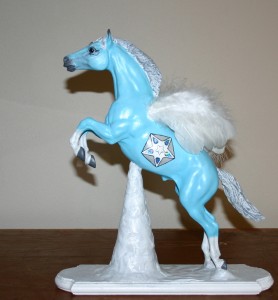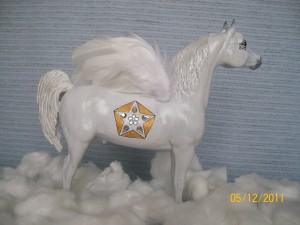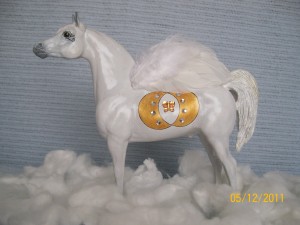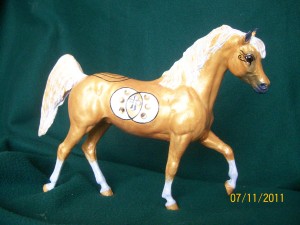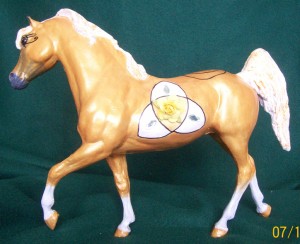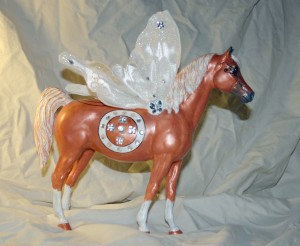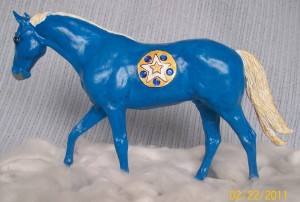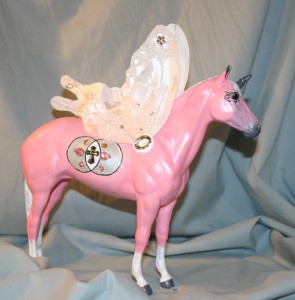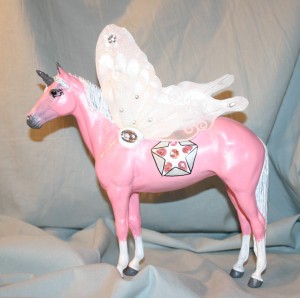Bright Spirit Horses with Sacred Geometrical Designs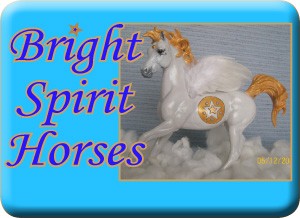
Many cultures have imagined spirit horses as guides on the inner journey. Southwestern native Americans typically painted these horses turquoise blue with white manes and tails. Some cultures imagine the horses as white. Some meditation practices ask the practitioner to focus on the “third eye” inside one’s forehead, where the color cerulean sea blue appears.
It is natural to pair these magnificent animals with symbols of the spiritual journey expressed in geometrical form–mandalas, mandorlas, third eyes, pentagonal stars, unicursal triquetras, and stars of David. Labyrinths, bindus, and the Eye of Horus round out images pointing one toward the divine.
All horses are about 8-9 inches tall and made of plastic, unless otherwise indicated.
These are just a few of the styles available. Please contact me for more options.
For an explanation of each symbol, please scroll to the bottom of the page.
Each is $97 plus $12 S&H. Please include a description of your choice with your secure Paypal order.
Sky blue stallion with feathered wings, Star of David, pentagonal star, and Eye of Horus.
White stallion with feathered wings, pentagonal star, mandorla, and Eye of Horus.
Golden stallion with mandorla, unicursal triquetra, Celtic labyrinth, and Eye of Horus.
Copper mare with butterfly wings, mandala, unicursal triquetra, and Eye of Horus.
Cerulean Sea blue stallion with pentagonal star, third-eye star, Celtic Labyrinth, and Eye of Horus.
Pink with butterfly wings, unicorn horn, mandorla, pentagonal star, and Eye of Horus.
Sacred Geometrical Designs
STAR WITHIN A PENTAGON
The 5-pointed star typically symbolizes the star that shone over Bethlehem when Jesus was born. It also is used to symbolize the human body, representing two outstretched arms, two legs, and the head; the five physical senses; or the five elements of spirit, fire, air, water, and earth.
MANDALA
In various spiritual traditions, mandalas are used for focusing attention, as an aid to meditation and trance induction, as a spiritual teaching tool, and for creating a sacred space.
THIRD EYE
With eyes closed, an experienced meditator might focus on the third eye, located between the eyebrows on the forehead. A band of gold surrounds a cerulean sea blue circle, and a white star appears in the center.
STAR OF DAVID
Also known as the Seal of Solomon and the Seal of Melchizedek, this symbol is formed by two interlocking triangles representing the sacred union of heaven and earth, spirit and flesh. This marriage creates the I Am That I Am.
MANDORLA
The Mandorla, or Vesica Piscis, is an ancient symbol of two overlapping circles. The almond shape in the center is a space where transformation can occur. The Mandorla represents the intersection of human and divine, heaven and earth, life and death.
UNICURSAL TRIQUETRA
Three arcing lines intersect to create the primordial flower of life. In Christian tradition this was seen as the trinity of God. It also represents other three-in-ones: body, mind, and spirit; earth, sea and sky; and the goddess as virgin, mother, and crone.
LABYRINTH
Labyrinth was the name given by the ancient Greeks and Romans to buildings containing a number of chambers and passages that made egress difficult. Labyrinth walking is an ancient practice used by many different faiths for spiritual centering, contemplation, and prayer. Entering the serpentine path of a labyrinth, the person walks slowly while quieting the mind and focusing on a spiritual question or prayer.
EYE OF HORUS
A sacred amulet from Egypt, it is the left eye of the falcon-headed god Horus, son of Queen Isis and Pharaoh Osiris. The symbol represents healing qualities.
BINDU
The bindu symbolizes the unmanifested cosmos, a point at which the single becomes the many.
SEO: blue spirit horse, blue spirit horses, spirit horses, spirit horse, sacred horse, sacred horses, blue horse, blue horses, Breyer, Peter Stone, horse, model horse, meditation, inner journey, sacred geometry, mandala, bindu, mandorla, pentagonal star, star of David, unicursal triquetra
(Copyright 2010)
